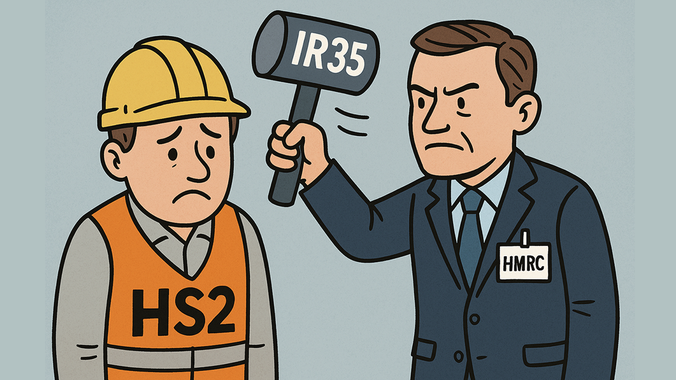The UK's flagship infrastructure project, High Speed 2 (HS2), is once again under intense scrutiny. This week, The Guardian revealed that the railway's timeline has been pushed back beyond 2033, and the Construction Enquirer reported serious fraud allegations now prompting a ministerial probe. The Spectator went further, calling HS2 "a scandal" and a "symbol of everything that is wrong with modern Britain." Cost overruns, delays, and now accusations of malpractice threaten to derail what was once billed as Europe's most ambitious transport project.
But while this latest cluster of problems is dominating headlines, many of the root issues appear to have germinated years earlier - specifically, in the spring of 2017. That's when HMRC's IR35 Off-Payroll reforms came into effect for the public sector, triggering a seismic shift in how contractors were treated - and how many decided to walk away.
Warnings Ignored: ContractorCalculator's Historic Reporting
June 2018: Blanket Bans and Talent Drain
The first major warning came from former HS2 contractor James Horabin in June 2018. In an exposé published by ContractorCalculator, Horabin revealed that HS2 had issued a blanket IR35 assessment, forcing nearly all contractors into PAYE or umbrella arrangements without individual status assessments.
Contractors like Horabin, who had clear evidence they were operating outside IR35 - including substitution rights, business insurances, and independent control over work - were ignored. Many refused to accept a de facto 30% pay cut and left. Horabin's prediction that HS2 would face major recruitment problems was chillingly accurate.
May 2019: 98% of Contractors' Inside IR35'
In 2019, another ContractorCalculator investigation used Freedom of Information requests to show that 98% of IR35 assessments conducted by HS2 in 2018 were deemed "inside IR35."
Such a figure far exceeded HMRC's own estimate that only one-third of contractors should fall within scope. Evidence suggested HS2, like Network Rail, adopted a blanket or role-based approach using HMRC's flawed CEST tool, resulting in false employment and contractor walkouts. A recruiter even described roles as "automatically inside IR35," making them financially untenable for top-tier contractors.
August 2022: Legislative Chaos and a £9.5 Million Tax Bill
In 2022, HS2's annual accounts disclosed £9.5 million in tax errors related to the IR35 rules - mistakes that could have cost the Treasury up to £8 million due to a flaw in the legislation.
When public sector clients misclassified contractors, they shouldered the tax bill, even though the contractor has already paid tax via their limited company. As both the National Audit Office and the Public Accounts Committee confirmed, the result is a net tax loss. The legislative gap was described by IR35 Shield CEO Dave Chaplin as a "farce." It also highlighted the chaotic mismanagement that seemed to be embedded in HS2's administrative culture.
It was not until April 2024 that the flawed legislation was amended, using the offset rules campaigned for by ContractorCalculator as part of it's "fix or ditch" message. ContractorCalculator provided evidence to both the NAO and PSC. By then, though, the damage was already done, and not just to HS2.
Root Cause: When the Rug Was Pulled in 2017
Projects of HS2's magnitude typically use Root Cause Analysis (RCA) to identify systemic failures. If applied here, RCA would likely trace many of today's issues back to 06 April 2017 - the day IR35 reforms were enforced in the public sector.
That single policy change dramatically reshaped the HS2 workforce. Instead of assessing employment status individually, HS2 and other public sector bodies enforced sweeping, legally questionable practices. The resulting exodus of skilled contractors not only delayed key deliverables but also forced HS2 to fill roles with permanent employees or agency workers, often at higher daily rates.
The irony is bitter. As costs spiral and more people are paid higher salaries to fill gaps left by exiting contractors, HMRC collects more tax. What appears to be a cost overrun to the public could be viewed by HMRC as a win: higher payroll taxes, increased PAYE revenue, and a short-term Treasury boost. But this is a false economy.
In reality, HS2's bloated budgets and delays are a tax on efficiency and competence. The talent loss caused by the heavy-handed implementation of IR35 was not just a human resources issue - it was a fatal flaw in project management.
Conclusion
As the investigations into fraud and mismanagement at HS2 gather pace, we should not overlook the quieter but more damaging decision taken in April 2017. That was the moment the project's foundations were weakened—not by engineers or planners, but by bureaucrats and tax policy. The departure of key skilled contractors destabilised timelines, inflated costs, and arguably paved the way for further dysfunction.
Ironically, HMRC may view the rising cost of HS2 as a success story - more people employed means more tax revenue. However, what the Treasury gains in revenue, the nation loses in terms of delivery and value for money.
HS2's collapse is not just a scandal of today - it's a reckoning with decisions made years ago, whose full consequences are only now being realised.

